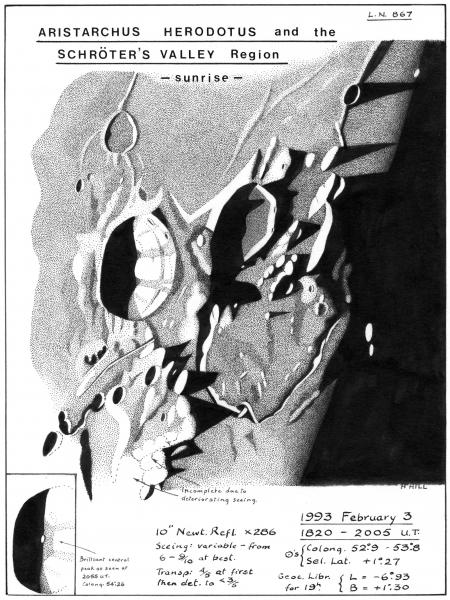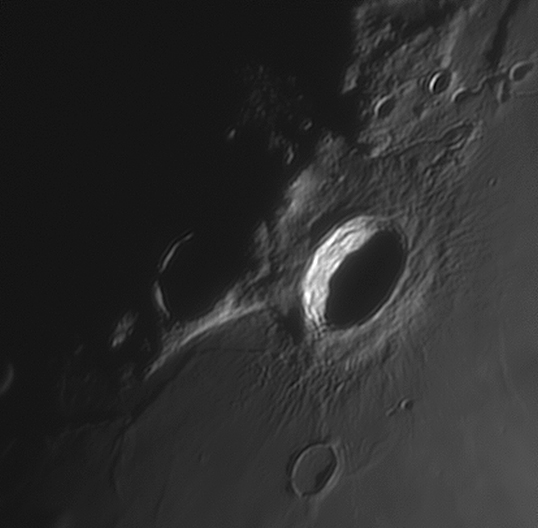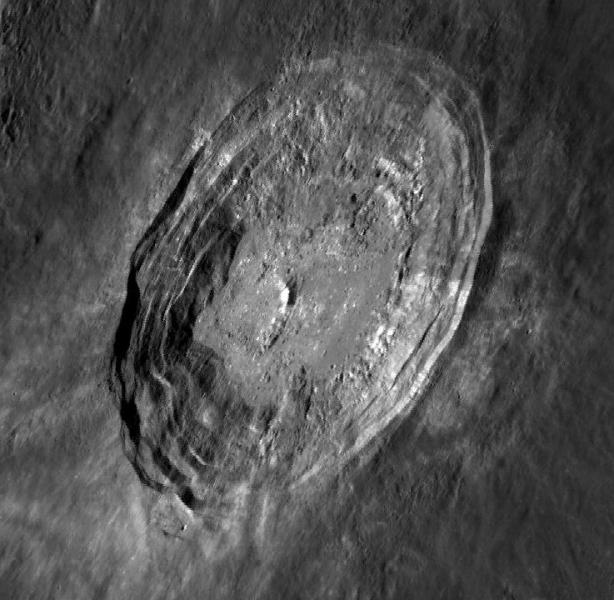Aristarchus – the bands disbanded?
2021 February 2

The 40km crater Aristarchus, located on the Oceanus Procellarum, is a favourite target for lunar observers and is unmistakable because of its extreme brightness. This brightness throws into relief a peculiar feature of the crater’s inner terraced walls – the fact that these are traversed by a series of dusky bands more or less radial to the crater’s centre. These radial bands have long been observed by amateur astronomers and were the subject of particular attention by Lunar Section members during the 1950s and 1960s.
The Aristarchus bands have been known to observers since the 19th century, but it was only in 1955 that Keith Abineri and Alan Lenham published a paper in this Journal that offered a categorisation and distribution of 188 similarly banded craters, thus showing that Aristarchus was by no means the sole example.1 More than a decade before that Robert Barker had published a paper in Popular Astronomy in which he argued that the Aristarchus bands might be variable in both extent and intensity, leading him to the conclusion that accelerating ‘evolutionary change’ was taking place that spoke of the possible ‘growth of lowly vegetation on another world, 240,000 miles distant’.2
By the 1960s the idea of vegetation on the Moon had largely receded, but the Aristarchus bands continued to puzzle. I read a paper on the subject at the Keele meeting of the Lunar Section on 1966 July 23, (the day on which England, on their way to World Cup glory, beat Argentina in the quarter-finals!). Following discussion at that meeting with Patrick Moore, Leslie Rae, Keith Abineri and Harry Thornton, I published papers in which I suggested that dusky bands like those in Aristarchus might be caused by scree accumulating at the bottom of radial dykes, although it was not clear to me how such dykes might have formed.3
In recent years the Aristarchus bands have seemed less prominent to me than I recall them being in the 1960s. I had put this down to declining acuity of vision, but images secured on the evening of 2020 Nov 26 suggest that other factors might be at work. For a start I am now using bigger and better telescopes; Barker had suggested that in larger aperture telescopes with greater resolution the bands appeared to break down and take on a granular appearance. While processing my images from Nov 26 I noticed that they were much more prominent as well-defined bands in the raw stacked image – i.e. before the application of wavelet sharpening enhanced the resolution of finer detail.

In the sharpened image the terracing detail within Aristarchus is clearly resolved and the ‘bands’ are shown to be simply part of that, losing their familiar banded appearance. What is more, the very much greater resolution offered by LROC imagery makes it absolutely clear that any ‘bands’ are nothing more than a consequence of the catastrophic wall failure and slumping that followed the impact process out of which Aristarchus was born.

So it would appear that the Aristarchus bands, and no doubt those in other banded craters, might have lost much of the importance they were held to have in the 1950s and 1960s. However, I would still be pleased to receive members’ images of such banded features for the Lunar Section archive.
Bill Leatherbarrow, Director, Lunar Section
References
1 Abineri K. W. & Lenham A. P., ‘Lunar banded craters’, J. Br. Astron. Assoc., 65(4), 160–166 (1955)
2 Robert Barker, ‘The bands of Aristarchus’, Popular Astronomy, 50 (1942 April), 192–195
3 Leatherbarrow W. J., ‘A survey of dark lunar radial bands’, J. Br. Astron. Assoc., 77(1), 33–38 (1966) and ‘A note on the formation of dark lunar radial bands’, J. Br. Astron. Assoc., 78(1), 41–42 (1967)
| The British Astronomical Association supports amateur astronomers around the UK and the rest of the world. Find out more about the BAA or join us. |
